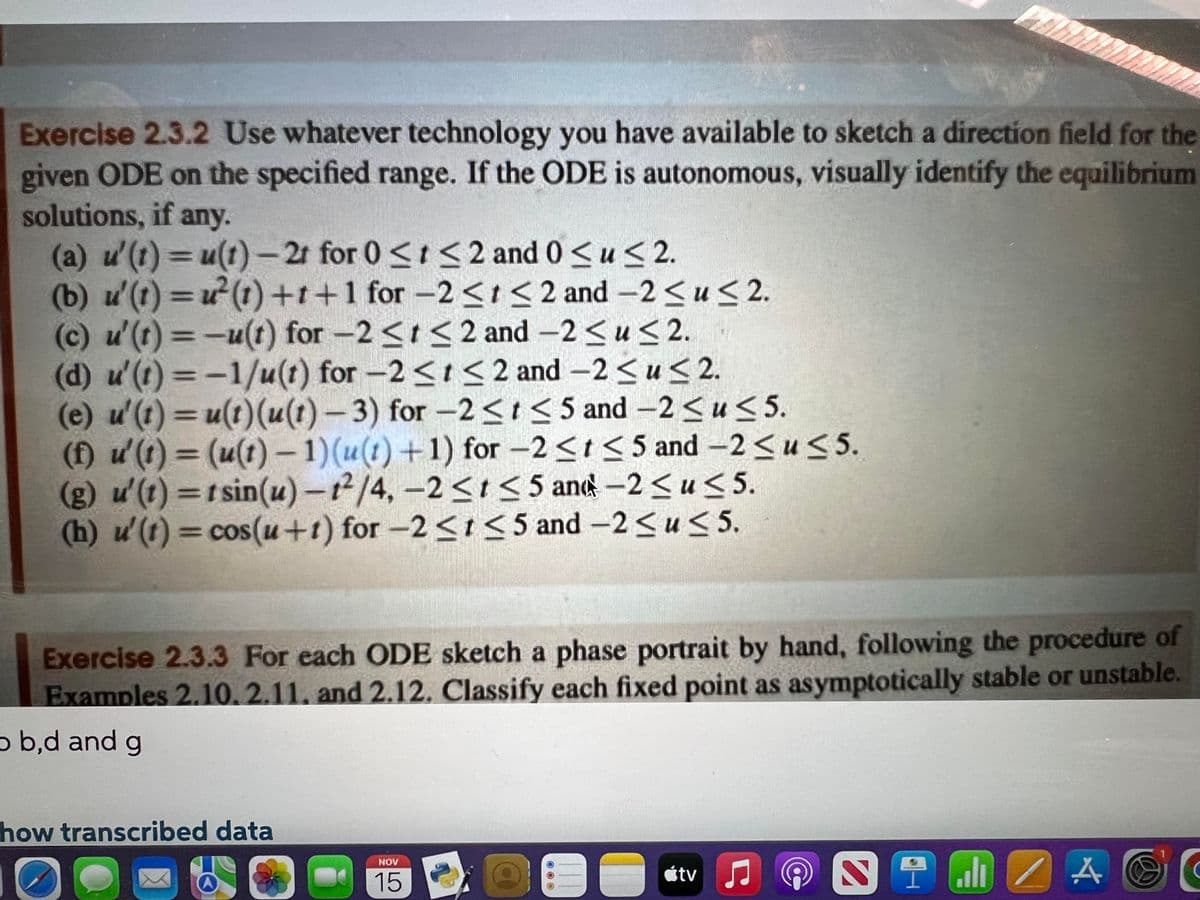Exercise 2.3.2 Use whatever technology you have available to sketch a direction field for the given ODE on the specified range. If the ODE is autonomous, visually identify the equilibrium solutions, if any. (a) u' (t) = u(t)-2t for 0 ≤t≤2 and 0 ≤ u ≤ 2. (b) u'(t)=u²(1)+1+1 for -2 <1 ≤ 2 and -2 ≤u≤ 2. (c) u' (t)=-u(t) for -2 ≤t≤2 and -2 ≤ u ≤ 2. (d) u'(t) = -1/u(t) for -2 ≤t≤2 and -2 ≤ u≤ 2. (e) u'(t) = u(t) (u(t)-3) for -2≤t ≤5 and -2 ≤u≤ 5. (f) u' (t) = (u(t)-1) (u(t) +1) for -2 <1 ≤5 and -2 ≤u≤5. (g) u' (t)=tsin(u)-12/4,-2 ≤t≤5 and -2 ≤u≤5. (h) u' (t) = cos(u+1) for -2 <1 ≤5 and -2 ≤ u ≤ 5. Exercise 2.3.3 For each ODE sketch a phase portrait by hand, following the procedure of Examples 2.10.2.11, and 2.12. Classify each fixed point as asymptotically stable or unstable. b,d and g
Exercise 2.3.2 Use whatever technology you have available to sketch a direction field for the given ODE on the specified range. If the ODE is autonomous, visually identify the equilibrium solutions, if any. (a) u' (t) = u(t)-2t for 0 ≤t≤2 and 0 ≤ u ≤ 2. (b) u'(t)=u²(1)+1+1 for -2 <1 ≤ 2 and -2 ≤u≤ 2. (c) u' (t)=-u(t) for -2 ≤t≤2 and -2 ≤ u ≤ 2. (d) u'(t) = -1/u(t) for -2 ≤t≤2 and -2 ≤ u≤ 2. (e) u'(t) = u(t) (u(t)-3) for -2≤t ≤5 and -2 ≤u≤ 5. (f) u' (t) = (u(t)-1) (u(t) +1) for -2 <1 ≤5 and -2 ≤u≤5. (g) u' (t)=tsin(u)-12/4,-2 ≤t≤5 and -2 ≤u≤5. (h) u' (t) = cos(u+1) for -2 <1 ≤5 and -2 ≤ u ≤ 5. Exercise 2.3.3 For each ODE sketch a phase portrait by hand, following the procedure of Examples 2.10.2.11, and 2.12. Classify each fixed point as asymptotically stable or unstable. b,d and g
Linear Algebra: A Modern Introduction
4th Edition
ISBN:9781285463247
Author:David Poole
Publisher:David Poole
Chapter4: Eigenvalues And Eigenvectors
Section4.6: Applications And The Perron-frobenius Theorem
Problem 69EQ: Let x=x(t) be a twice-differentiable function and consider the second order differential equation...
Related questions
Question
Do b, d, and g
Also make sure to describe and identify the equilibrium solutions

Transcribed Image Text:Exercise 2.3.2 Use whatever technology you have available to sketch a direction field for the
given ODE on the specified range. If the ODE is autonomous, visually identify the equilibrium
solutions, if any.
(a) u'(t) = u(t)-21 for 0 ≤t≤2 and 0 ≤u≤ 2.
(b) u' (t)=u²(1)+1+1 for -2 ≤t≤ 2 and -2 ≤ u ≤ 2.
(c) u'(t)=-u(t) for -2≤t≤2 and -2 ≤ u≤ 2.
(d) u'(t)=-1/u(t) for-2≤t≤2 and -2 ≤ u≤ 2.
(e) u'(t) = u(t) (u(t)-3) for -2≤t≤5 and -2 ≤u≤ 5.
(f) u'(t) = (u(t)-1) (u(t) +1) for -2 ≤ t ≤5 and -2≤u≤5.
(g) u'(t)=tsin(u)-12/4, -2≤t≤5 and -2 ≤u≤ 5.
(h) u' (t) = cos(u+t) for-2≤1 ≤ 5 and -2 ≤ u≤ 5.
Exercise 2.3.3 For each ODE sketch a phase portrait by hand, following the procedure of
Examples 2.10. 2.11. and 2.12. Classify each fixed point as asymptotically stable or unstable.
ob,d and g
how transcribed data
O
NOV
15
átv
Ç
alı
ZA
Expert Solution
This question has been solved!
Explore an expertly crafted, step-by-step solution for a thorough understanding of key concepts.
This is a popular solution!
Trending now
This is a popular solution!
Step by step
Solved in 4 steps with 4 images

Recommended textbooks for you

Linear Algebra: A Modern Introduction
Algebra
ISBN:
9781285463247
Author:
David Poole
Publisher:
Cengage Learning

Linear Algebra: A Modern Introduction
Algebra
ISBN:
9781285463247
Author:
David Poole
Publisher:
Cengage Learning